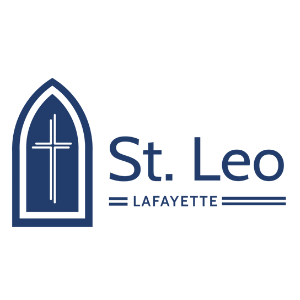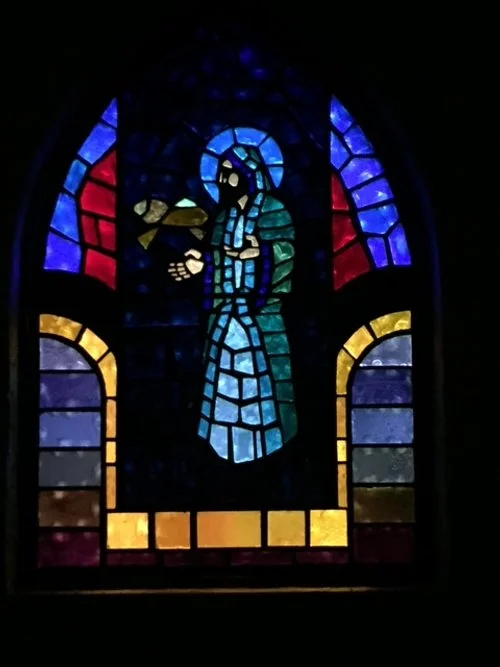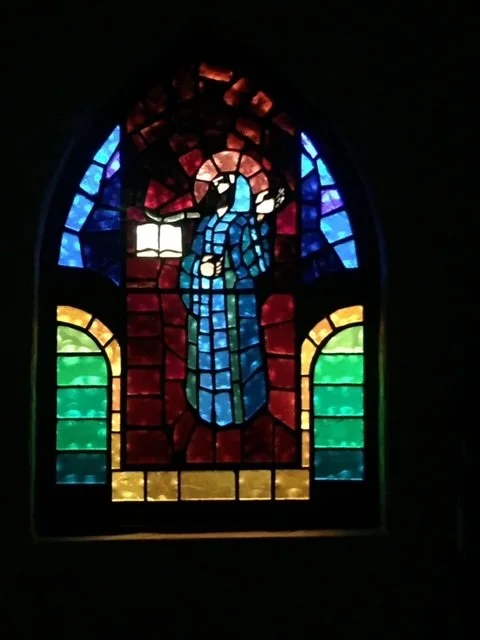The windows in our church were made using a technique known as “dalle de verre”. Dalle de verre is French for “glass slab” and is a glass art technique that uses pieces of colored glass set in a matrix of concrete and epoxy resin.
Each window in the nave of our church depicts one of the 12 Apostles.
Peter is shown holding the keys to the kingdom.
“…And so I say to you, you are Peter, and upon this rock I will build my church,* and the gates of the netherworld shall not prevail against it. I will give you the keys to the kingdom of heaven.* Whatever you bind on earth shall be bound in heaven; and whatever you loose on earth shall be loosed in heaven.” (Matthew 16:18-19)
Andrew is shown with a fish on an x-shaped cross, as he was a fisherman by trade, who became a fisher of men, and was crucified on an x-shaped (saltire) cross. You may really have to use your imagination to see this.
James the Greater is shown with scallop shells. There are a lot of stories going around about the origin of the scallops. The most common one is related to the death of Saint James in 44 AD. As the story goes, his body was lost in the ocean during a heavy storm when his remains were being transported by his disciples from Jerusalem to Spain, where he had spread the Gospel after the death of Jesus . When his body washed ashore in Galicia, it was covered in scallop shells.
John is holding a chalice with a snake. According to legend, he was given a cup of poisoned wine, but the poison came out of it in the form of a snake, and he drank the cup without incident. John was the only one of the Apostles who did not die a martyr’s death, but there were certainly some who tried to kill him. Notice also that John is the only apostle who is clean-shaven.
Jude is holding a boat to symbolize his travels on long missionary journeys. Ancient writers tell us that he preached the Gospel in Judea, Samaria, Idumaea, Syria, Mesopotamia, and Libya. He is thought to have brought Christianity to Armenia. Sometimes known as Jude Thaddeus (or just Thaddeus), he is the patron saint of desperate causes.
James the Less is often depicted with clubs or stones, the instruments of his martyrdom. It is likely that the clubs used would be larger than what is shown here. He is known as “James the Less” because he was likely younger or shorter than “James the Greater”; not because he was less important.
Philip is holding a basket full of bread with a T-shaped cross. The breadbasket points to Philip’s involvement in feeding the 5000. When he was on the cross, he continued to preach and so moved the crowd that they took Bartholomew down. When they came to remove Philip, he insisted that he stay. Thus the cross is often included with the bread basket.
Bartholomew is shown with a bible and a flaying knife. There are varying accounts about how he died. In one account, he was crucified upside down, but removed from the crucifix as the result of Philip’s preaching. Most commonly, it is said that he was skinned alive, and he is often depicted holding his skin. Some think that he was beheaded. Some think that Bartholomew may also be known as Nathaniel. It is thought that he spread the Gospel in India after the death of Jesus,
Thomas is holding a carpenter’s square and is shown with a spear (or an arrow). The square symbolizes his profession as a builder, and he was martyred with a spear
Matthew is shown with 3 money bags, which symbolize his past as a tax collector.
Simon is pictured with a fish on a bible that shows that he was a former fisherman who became a fisher of men by preaching.
Matthias is depicted with a scimitar, the instrument of his martyrdom and a bible because he was well-versed in scripture.












